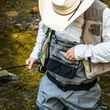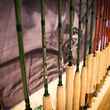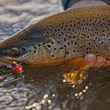Now that you’re squared away with the right fly tying tools and materials (and if you’re not, be sure to check out our primer on tools and materials for beginning tyers), it’s time to get to work and start tying. As you begin to experiment with your first patterns and develop your skills, small tips and tricks can make big differences in your precision and efficiency and, ultimately, the quality of the flies you tie. And so, to help you get started, here are six of my favorite fly tying tips.
-
Seeing is believing: Use a backdrop for contrast
-
Place your vice head high to reduce neck pain
-
Reel In thread for speedier wraps
-
Become Edward Scissorhands
-
Practice breaking your thread
-
Avoid tying with dry hands
Having a lighter color behind your fly will help create additional visual contrast. A lighter table top or strategically adding a piece of white paper behind the vise will help your fly to stand out, allowing you to more easily see the details of your fly, as well as reducing eye strain. Some manufacturers even offer background plates, which mounted onto your vise stem.
For example, ribbing is the technique of winding a thin material onto the fly body to create segmentation. Generally, you'll want each rib spaced equally. A lighter background will allow you to better see the placement of each wrap, which will result in a better tied pattern.
It’s worth noting that you shouldn’t expect that accurately spacing each rib is going to up your catch rate. Proper proportions are far more important to the fly fisher than the fish. But there’s something satisfying creating a fly that is aesthetically pleasing.
This may sound like common sense, but I can assure you it’s not. The height of the head of your vice should be as high as your shoulders (or higher), reducing the downward angle of your head and neck while tying flies. This can be accomplished by adjusting the height of the vise head (if possible with your vise model) or by using a chair or table that can raise or lower. Otherwise, you’ll likely develop neck pain if your head is angled too far downward for an extended period of time. It may take some tinkering to get your setup just right, but it’s more than worth it in the end.
Point your finger at an object and make very short circles. Now, open up your wrist and try making larger circles with your finger. Notice how much longer it takes to make one large circle compared to a small circle. In other words, the speed you wrap thread around the hook is increased the closer you keep the bobbin to the hook. Not only will you increase speed, but you’ll have more control while wrapping thread. If you find the bobbin getting pulled too far from the hook and notice you’re making wider/slower wraps, shorten the distance between hook and bobbin by reeling in thread, and you’ll regain control and up your speed.
Scissors are used constantly throughout the tying process to cut materials and thread. If you place your scissors on the table in between each cut, you’ll find yourself constantly taking your eye off the fly while trying to locate your snips. This is a huge time suck for beginner tyers. Instead, find a small pair of scissors that fit comfortably in the palm of your hand and stay there while you’re tying. Or, if you prefer larger scissors, experiment with holding them in a manner that won’t interfere with your tying. You’ll be amazed how much time is saved by keeping scissors in your hand. It provides a major boost to your efficiency, reduces frustration, and keeps the flow of your fly tying moving. For me, the way different pairs of tying scissors feel in my hand is akin to wearing different pieces of clothing. Some are comfortable while others are not. Comfy fly tying scissors in your hand is one of life’s simple pleasures, so spend time finding a pair that fits you.
A common mistake made by beginners is not applying enough tension while wrapping thread, in fear of breaking off thread. But thread wraps act as a binding agent between hook and material. Think of wraps as a noose holding your material onto the hook. The tighter the noose, the less likely the material will slip or pull away from the hook. If your wraps are too light, then your fly is likely going to fall apart when you fish it. This is why I feel it’s good practice to spend time intentionally breaking your thread while wrapping it on a bare hook shank. Experiment until you have a feel for the breaking point of the thread you’re using, the maximum amount of pressure you can use while wrapping. Once you find that breaking point, step back the pressure just a notch or two, and you’ll be creating a li bond between your hook and materials. A durable fly can catch dozens of fish before falling apart. If you have a bobbin threader, keep it handy while you practice breaking your thread so you can quickly rethread the bobbin after each break.
Dry hands act like sticky pads (think tree sap on your hands) to both tying thread and materials. Use lotion to keep your hands moist and smooth, and you’ll find far less material and threat sticking to you hands and complicating your tying.































Comments
Jason R. replied on Permalink
I seem to break my thread far too easily. My bobbin has the ceramic ring at the end, but it doesn't seem to matter. Any suggestions?
David R Poindexter replied on Permalink
I Read where a person purchased a ceramic bobbin that had a burr. Another, said the ceramic bead was not centered. While you could polish the bobbin tips of metal and brass bobbins with a spinning tooth pick and polishing rouge, ceramic would prove more difficult. Perhaps it is time for you to purchase a new bobbin. One with a guarantee?
Jason R. replied on Permalink
I suppose so, as long as it isn't user error on my part (which is what I suspect). Do you have any recommendations?
David R Poindexter replied on Permalink
Hi, My original answer was to share with you that sometimes a 'manufacturing defect' can happen in a presumed 'Quality Product'. I paid a high premium for a Ruby-edged leather carving blade one time. Turned out to be truly awful because of a small burr. I also purchased a 'bad' fuel pump and it took forever and a Friend to eventually 'double check' it worked (or not). And, we have all probably replaced a bad Bulb with another bad Bulb before. Back to your question. I like the idea of using a bare hook in your vice and then purposely straining your threaded bobbin to find the breaking point. Then obviously tie with your pressure pull being less. This would also allow you to adjust between threads of different weights, breaking points, quality of the thread, and more. Also, we all use enough mass-produced items to know there can be different characteristics within the 'same batch'. As far as a New Bobbin Holder...I would buy another Griffin Ceramic Tipped one. One I could return if not happy with it. J. Stockard on line us one source.
Anonymous replied on Permalink
Makes perfect sense. Thanks for the help!
No1Hunter replied on Permalink
How do you thread your bobbin? Are you using a metal threader? They can damage the ceramic in the bobbin. If you buy a new bobbin, I recommend using a dental floss threader that people use with braces. You can get a pack of 50 for $5 or $6 bucks.
Richard Moxham replied on Permalink
Thank you for this article. I have been tying for many years and it's always good to receive these ideas and suggestions. I particularly like the need to find and ergonomic sitting position for you and the vise. Is it possible to do an article on threads in the future. What does 8/0 mean or 136D? I have a wide mix of threads from pure silk (passed down) to modern brands and there is such a variation. I like the older one for colour but they are never as strong as modern threads. Thanks again for this information.
Pages